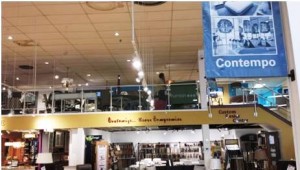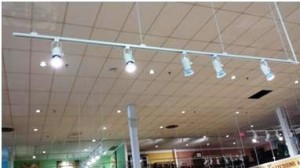One way to categorize lamps is by the direction in which they give off light. “Point” lamps give off light equally in all directions. A good example is the traditional incandescent light bulb. “Directional” lights emit parallel light, all of it traveling through a space in the same direction.
Directional lamps are a key component of the lighting systems used in retail, hotels, restaurants, museums – anywhere that a discrete item or space needs to be illuminated. They come in different shapes and sizes suited to a variety of applications.
- Parabolic aluminized reflector (PAR) lamps are used in track, recessed and outdoor spot and floodlights. Like all bulbs, they are identified by their diameter in eighths of an inch (PAR30, 38, 56, etc.). They have a hard glass cover sealed to the reflecting surface, which is made of aluminized glass.
- Multifaceted reflector (MR) lamps are so named because the inside surface is composed of numerous glass facets covered by a reflective coating. Small and flexible, MR lamps provide good beam control and are quickly becoming the standard in galleries, museums, restaurants, and retails, usually as track lighting and recessed downlights. The most common MR lamp is the MR16, which has a diameter of 16 eighths of an inch (two inches).
- BR bulbs have a bulged reflector that can be clear, frosted, or even patterned. That frosting, together with the fact that they produce a softer-edged beam and less shadow than PAR lamps, gives them a desirable appearance for indoor applications.
Increasingly, halogen directional lamps are being replaced with LED’s. The Department of Energy’s research on directional LED lamps has revealed that they:
- Can achieve energy savings of 75 percent or higher
- Have a high CRI, between 80 and 85
- Typically deliver lower lumen outputs and involve higher upfront costs than halogens, but theoretically have a longer useful lifetime (they are still in the process of being tested for that)
- Radiate less ultraviolet and infrared energy (valuable in museums where UV and IR can degrade items on display)
- Have traditionally offered a limited range of distributions (unlike halogens, which range from narrow pin spots to wide floods), although new products are constantly coming on the market.
- Need to be installed in a way that allows for removal of heat away from lamps, or they become discolored and suffer shortened life expectancy and decreased lumen output. This is more challenging in a closed environment, such as track heads.
- Might be a different size or shape than halogen lamps they are replacing, making it difficult to fit into existing track head.
These issues indicate that a simple retrofit from halogen to LED might not be so simple. But if this is a project you’ve been considering, our lighting engineers can provide guidance. Click here to get in touch with them.


